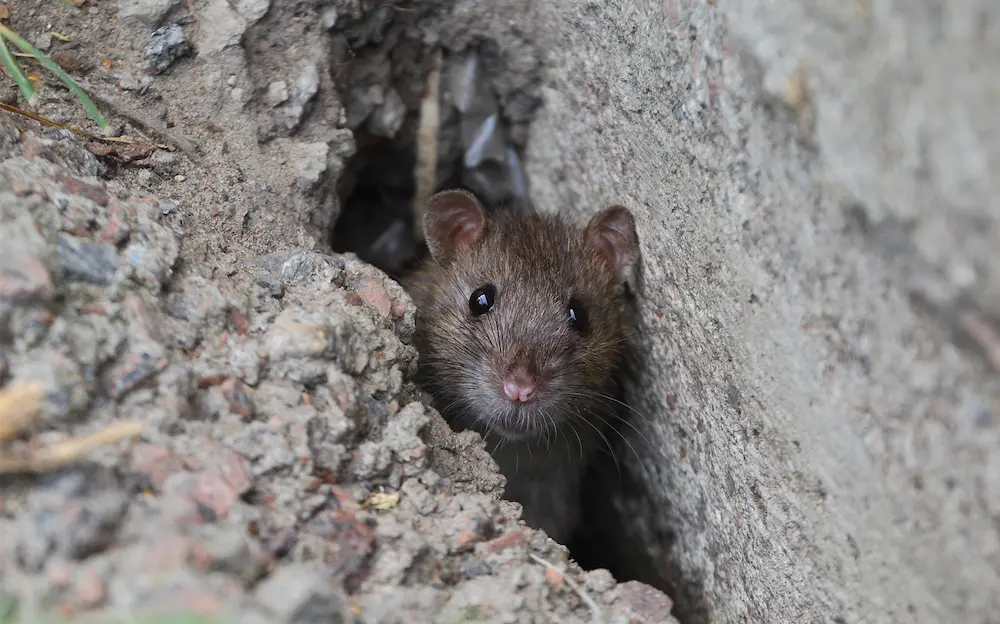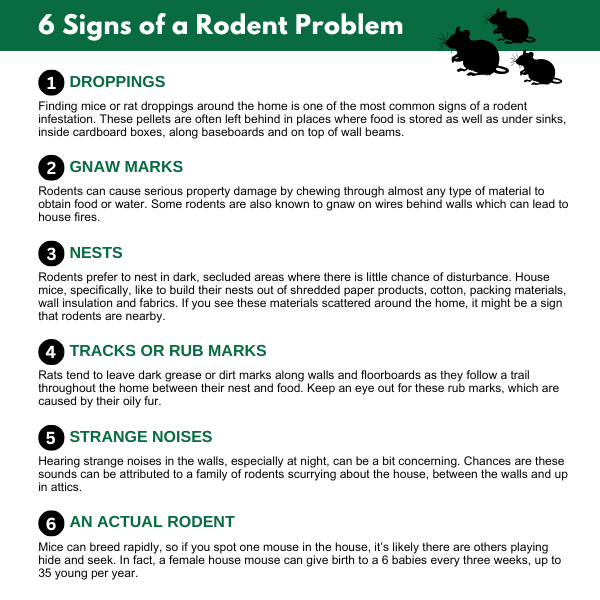Serving Central, West Central, and Southwest Florida
Six Clues You Might Have a Rodent Problem
The first step in protecting your Florida home from a rodent infestation is learning what to look for. Mice and rats are stealthy, nighttime explorers that move quietly through walls and crawl spaces in search of food. While they may be good at keeping out of sight, they leave behind plenty of evidence. If any of the following clues sound familiar, it’s time to check for rodents.
The six clues that reveal a possible rodent problem. Click to skip to any section:


What Are the Clues You Might Have a Rodent Infestation?
Rodents often leave behind subtle but revealing clues long before you ever see one. From faint scratching in the walls to small chew marks on furniture, these details can expose a hidden infestation. Paying attention to these early hints can save you from larger problems later.
Keep an eye out for the following indicators that rodents may be nearby:
Droppings
This is usually the first and most dependable clue that rodents are present. The size and shape of what you find can reveal whether you’re dealing with rats or mice. Here’s how to recognize what each type of dropping looks like:
- Mouse Droppings: These tiny droppings measure about 1/8 to 1/4 inch long and resemble grains of rice with pointed ends. Because a single mouse can produce 50 to 80 droppings a day, they’re often scattered in cupboards, drawers, or along baseboards where mice travel.
- Rat Droppings: Larger than mouse droppings, these measure about 1/2 to 3/4 inch and have rounded or blunt ends, resembling small beans or olive pits. Fresh droppings appear dark and glossy, while older ones turn gray, become dusty, and crumble easily when touched.
Inspect hidden areas such as behind appliances, under sinks, inside cabinets, and near baseboards where droppings or chew marks may appear.
Gnaw Marks
Because a rodent’s front teeth never stop growing, they must chew regularly to prevent overgrowth. This chewing can cause structural damage and create safety hazards. Look for these warning signs of gnawing:
- Mice: Leave small, precise gnaw marks that look like fine scratches, often found on soft wood, cardboard, or insulation. They chew to access food or nesting spots.
- Rats: Leave deep, rough gouges from their larger teeth, chewing through wood, plastic, and even soft metals like aluminum. Their damage is often more extensive than that of mice.
Survey corners of walls, cabinets, packaging for grains or pet food, and electrical wires. Chewed wires not only point to rodent activity but also present a serious fire hazard.
Nests and Nesting Material
Rodents build nests by collecting and shredding soft materials they discover around your home. While the nest itself is often hidden, signs of their activity are easier to spot. Here are some common clues to look for:
- Mice Nests: Mice create small, meticulously shredded nests that look like loose balls of fluff. These can be found behind appliances, inside cabinets, within wall voids, or in the corner of a rarely used drawer.
- Roof Rat Nests: Roof rats are skilled climbers and build their nests high up in attics or ceiling voids where they are safe and hidden.
- Brown Rat Nests: Brown rats shred materials to build nests, lining the burrows they dig in basements, crawl spaces, or along the foundation of your home.
Keep an eye out for little piles of shredded materials such as paper, fabric, insulation, or plant matter hidden in quiet spots.
Tracks and Rub Marks
The repetitive travel of rodents forms well-worn “highways” marked by greasy, darkened paths. These marks contrast with the cleaner areas around them. Check for these indicators of rodent movement:
- Rub Marks: As rodents travel along walls and baseboards, the oil and dirt from their fur leave behind dark, greasy smudges. Heavier marks usually indicate areas with more frequent rodent activity.
- Tracks: In dusty or seldom-used areas of your home, you might spot footprints or tail marks. Sprinkling a light layer of flour or cornstarch along a suspected path can help reveal activity, so check for fresh tracks the next morning.
These signs are often subtle but telling. Noticing rub marks or tracks early can help you identify rodent activity before an infestation becomes severe.
Strange Noises
Nighttime is prime activity time for rodents, making it the moment you’re most likely to hear them. Their movements often create distinct sounds. The following list highlights common noises to listen for:
- Scratching: Light, rapid sounds that may come from inside walls or ceilings as rodents move.
- Scurrying: Quick, shuffled noises that often occur under floors or behind walls.
- Squeaking: High-pitched sounds that can indicate communication between rodents or distress.
- Gnawing: Chewing noises are made when rodents gnaw on materials like wood, wiring, or insulation.
Listen carefully for unusual noises in the attic or kitchen after nightfall, as these are common areas where rodents are active.
Actual Rodents
Rodents often go unnoticed until signs of their presence become obvious. Identifying the type of rodent is an important step in addressing the problem effectively. Below are some common types of rodents found in homes in Florida:
- Roof Rats: These rats are slender climbers that often build nests in attics, ceiling voids, or trees. They are larger than mice and are known for their agility.
- Norway Rats: Also called brown rats, they are larger and stockier than mice and prefer to burrow in basements, crawl spaces, or along foundations. They are strong chewers and can cause significant damage.
- House Mice: The most common type of mouse in the area, they are small and highly adaptable, often nesting inside walls, cabinets, or cluttered spaces.
- Deer Mice: Typically found in heavily wooded areas, deer mice are distinguishable by their bi-colored fur and large eyes. They can carry diseases, making them a concern in certain environments.
Finding even one rodent indoors often indicates a larger infestation. This is a situation that should be addressed by a rodent control specialist as soon as possible.
When You Spot Signs of Rodents, Call Arrow Environmental Services
Seeing these rodent signs is a clear signal that they could be living and breeding in your home. We understand this can be stressful, but it also means we can act quickly to protect your home. Early detection gives us a better chance to stop the infestation before it spreads further, saving you time, money, and damage.
If you’re in Florida, let us help. Arrow Environmental Services will inspect your property and put together a plan that works for your needs and your peace of mind. Our team will explain each step of the process so you know exactly what to expect and feel confident that the problem will be handled effectively.
Call the rodent control experts at Arrow Environmental Services today for more information and a free estimate.
Back to Rodent Control